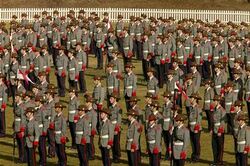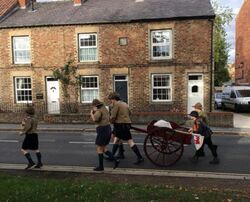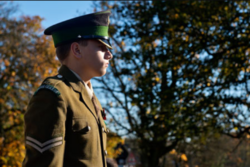King's Cadet Corps: Difference between revisions
No edit summary |
No edit summary |
||
| Line 16: | Line 16: | ||
| leader_name2 = Sir Stephen Daldey | | leader_name2 = Sir Stephen Daldey | ||
}} | }} | ||
'''His Majesty's Cadet Corps''' is a | '''His Majesty's Cadet Corps''' is a militaristic and patriotic youth organisation operating in [[Great Nortend]]. The Corps is run by the [[Ministry of Great Nortend|Board of Education]] and the [[HM War Office (Great Nortend)|War Office]] in conjunction with the [[Royal Erbonian Army|Royal Army]], the [[Erbonian Navy Royal|Navy Royal]], the Royal Servicemen's Club and the Erbonian Navy League. | ||
It developed from 19th century volunteer | It developed from 19th century volunteer companies raised in Erbonian independent schools as preparation for commission into the armed forces, with the support of the War Office. In the 20th century, the Board of Education raised companies into state senior schools for boys. In 1953, for the Golden Jubilee of Edmund IX, the Corps was formally established by Royal Charter. Successive monarchs since have served as Captain-General of Cadets. | ||
As of the start of 2019, there are 621,888 boys between the ages of 11 and 19 in the Corps | As of the start of 2019, there are 621,888 boys between the ages of 11 and 19 in the Corps. | ||
==Objects, motto and emblem== | ==Objects, motto and emblem== | ||
The objective of the Corps, as stated in its Royal Charter, is to promote, | The objective of the Corps, as stated in its Royal Charter, is to promote, “The advancement of Christian manliness, courage, discipline, reverence and self-respect, and to nurture patriotism and allegiance to God, Crown and country amongst the Boys of the Realm”. | ||
The motto, ''Honore pro Dei et patria'', is Latin for ' | The motto, ''Honore pro Dei et patria'', is Latin for 'By honour for God and country', was chosen by Richard Errol, the then Colonel of Cadets. The emblem of the Corps depicts the crossed swords of the Royal Army encircled in a band bearing the motto, surmounted by the royal crown. | ||
==Organisation== | ==Organisation== | ||
[[File:GNCadetAllord.jpg|thumbnail|left|250px|The cadet company of Allord College wears a distinctive grey form of the Dress Order II.]]The Cadet Corps are mostly run on a local basis in senior schools, with the majority of boys' senior schools operating a cadet company, independent, common and state. Cadets partake in land and some sea activities, although most companies skew towards land-based activities. | [[File:GNCadetAllord.jpg|thumbnail|left|250px|The cadet company of Allord College wears a distinctive grey form of the Dress Order II.]]The Cadet Corps are mostly run on a local basis in senior schools, with the majority of boys' senior schools operating a cadet company, independent, common and state. Cadets partake in land and some sea activities, although most companies skew towards land-based activities. Individual cadet companies are often associated with their local regiment, sharing in certain regimental traditions such as marches, songs and drill. | ||
Cadet companies are | Cadet companies are run by adult staff officers, assisted by senior cadets. Staff officers are usually both employees of the school wherein the company is based, as well as members of the Militia. Officers (of all rank) receive a formal commission from the [[Monarchy of Great Nortend|King]] as a Staff Officer of Cadets. Senior cadet officers, holding the rank of Cadet Ensign (or Cornet in units affiliated with the cavalry), typically in the 6th forms studying for either matriculation or commission into the [[Royal Erbonian Army|Royal Army]] or [[Erbonian Navy Royal|Navy Royal]], are also commissioned as an Under-Officer of Cadets. | ||
Within a company, there are usually multiple platoons. A platoon is commanded by an Ensign, with Lieutenants operating on a company level. Colour Serjeants and Warrant Officers hold appointments within the company, such as Company Serjeant Major and Company Quartermaster Serjeant. Within a platoon, the Serjeant serves as the second-in-command with sections commanded by Corporals and Lance Corporals. | Within a company, there are usually multiple platoons. A platoon is commanded by an Ensign, with (adult) Lieutenants operating on a company level. Colour Serjeants and Warrant Officers hold appointments within the company, such as Company Serjeant Major and Company Quartermaster Serjeant. Within a platoon, the Serjeant serves as the second-in-command with sections commanded by Corporals and Lance Corporals. | ||
Multiple companies, or multiple school units as it were, which are each individually commanded by a Major, are grouped into battalions commanded by a Major. Each battalion operates in a particular region, usually roughly corresponding to a county, although independent and common school companies have their own battalions covering a larger area each. | Multiple companies, or multiple school units as it were, which are each individually commanded by a Major, are grouped into battalions commanded by a Major. Each battalion operates in a particular region, usually roughly corresponding to a county, although independent and common school companies have their own battalions covering a larger area each. | ||
| Line 41: | Line 41: | ||
[[File:GNCadetPrd.jpg|thumbnail|left|250px|Cadets on parade in formal dress. Drill is a fundamental part of a cadet's instruction.]]The core component to cadet activities is based on general military training, usually focussing on the land warfare aspect, i.e. the Royal Army. This includes learning history of the armed forces, discipline, traditions, navigation, field surgery, drill, marksmanship and fieldcraft. Leadership skills are also important for cadet non-commissioned officers. | [[File:GNCadetPrd.jpg|thumbnail|left|250px|Cadets on parade in formal dress. Drill is a fundamental part of a cadet's instruction.]]The core component to cadet activities is based on general military training, usually focussing on the land warfare aspect, i.e. the Royal Army. This includes learning history of the armed forces, discipline, traditions, navigation, field surgery, drill, marksmanship and fieldcraft. Leadership skills are also important for cadet non-commissioned officers. | ||
Another component is patriotic service, which aims to inculcate love for God, King and country by engaging in what may be termed community service activities, as well as pilgrimages, camping, woodcraft, aquatic activities, hiking and sports. These two activities are evidently not mutually exclusive, and throughout all, appropriate military-level discipline and structure is maintained. | Another component is patriotic service, which aims to inculcate love for God, King and country by engaging in what may be termed community service activities, as well as religious pilgrimages, camping, woodcraft, aquatic activities, hiking and sports. These two activities are evidently not mutually exclusive, and throughout all, appropriate military-level discipline and structure is maintained. | ||
Cadet companies often organise weekends or weeks away in the countryside to these ends, with each company at least running an annual field exercise. On a more regular level, cadet companies usually have weekly or twice-weekly | Cadet companies often organise weekends or weeks away in the countryside to these ends, with each company at least running an annual field exercise. On a more regular level, cadet companies usually have weekly or twice-weekly musters on weekday afternoons. | ||
==Membership== | ==Membership== | ||
[[File:GNCadet2.png|thumbnail|250px|right|A cadet corporal on parade.]]Membership of the Corps is open to boys between the ages of 11 and 19 | [[File:GNCadet2.png|thumbnail|250px|right|A cadet corporal on parade.]]Membership of the Corps is open to boys between the ages of 11 and 19. The vast majority of cadets enter the Corps through their senior school. 83% of all boys' senior schools operate a cadet company and of these, membership of the Corps is compulsory in 90%. All in all, there are around 621,888 cadets in the Corps and around 20,000 staff officers. | ||
Nearly 90% of enlistees in the Royal Army have a prior cadet background. The connexions developed between cadet companies and local regiments are considered valuable for recruitment purposes. | |||
===Oath=== | ===Oath=== | ||
Joining the Corps requires that prospective members take the Oath of | Joining the Corps requires that prospective members take the Oath of Engagement to the [[Monarchy of Great Nortend|Sovereign]] in the form prescribed: | ||
<blockquote>I, A. B., do swear that I will be faithful and bear true allegiance to His Majesty King Alexander the Second, his Heirs and Succesours, according to law, as a cadet | <blockquote>I, A. B., do swear that I will be faithful and bear true allegiance to His Majesty King Alexander the Second, his Heirs and Succesours, according to law, as a cadet/staff officer in His Majesty's Cadet Corps. So help me God!</blockquote> | ||
==Ranks== | ==Ranks== | ||
| Line 110: | Line 112: | ||
==Uniforms== | ==Uniforms== | ||
The uniforms of the Corps | The uniforms of the Corps are in essence the same as the [[Uniforms of the Royal Erbonian Army|uniforms of the Royal Army]]. The normal uniform worn is the same as [[Uniforms_of_the_Royal_Erbonian_Army#Dress_Order_III:_Duty_dress|Dress Order III]] of the Army whilst the formal uniform is the same as [[Uniforms_of_the_Royal_Erbonian_Army#Dress_Order_II:_Undress|Dress Order II]]. The main difference is that royal blue shoulder patches are sewn onto uniform coats and tunics with the words 'H. M. Cadet Corps' embroidered in white, as well as the use of the Corps badge. Uniform items do not use real gold and silver thread, but rather cheaper alternatives. Staff officers as well as senior cadets may wear mess dress for cadet functions such as company messes. | ||
Cadets must wear the uniform of the Corps in accordance with the Corps uniform regulations. It must not be worn in conjunction with civilian items of clothing, and must be worn at all times at cadet events and activities, unless explicitly dispensed with. It must not be worn on other occasions. | Cadets must wear the uniform of the Corps in accordance with the Corps uniform regulations. It must not be worn in conjunction with civilian items of clothing, and must be worn at all times at cadet events and activities, unless explicitly dispensed with. It must not be worn on other occasions, lest one be charged with impersonation of a soldier. | ||
{{GNC}}[[Category:Organisations in Astyria]] | {{GNC}}[[Category:Organisations in Astyria]] | ||
Revision as of 16:30, 27 September 2019
The King's Cadet Corps | |
 Badge of the King's Cadet Corps | |
| Motto | Honore pro Dei et patria |
|---|---|
| Formation | June 5, 1876 |
| Type | Patriotic youth organisation |
| Headquarters | Lendert-with-Cadell, |
Membership | 622,134 |
Captain-General | Alexander II |
Colonel of Cadets | Sir Stephen Daldey |
His Majesty's Cadet Corps is a militaristic and patriotic youth organisation operating in Great Nortend. The Corps is run by the Board of Education and the War Office in conjunction with the Royal Army, the Navy Royal, the Royal Servicemen's Club and the Erbonian Navy League.
It developed from 19th century volunteer companies raised in Erbonian independent schools as preparation for commission into the armed forces, with the support of the War Office. In the 20th century, the Board of Education raised companies into state senior schools for boys. In 1953, for the Golden Jubilee of Edmund IX, the Corps was formally established by Royal Charter. Successive monarchs since have served as Captain-General of Cadets.
As of the start of 2019, there are 621,888 boys between the ages of 11 and 19 in the Corps.
Objects, motto and emblem
The objective of the Corps, as stated in its Royal Charter, is to promote, “The advancement of Christian manliness, courage, discipline, reverence and self-respect, and to nurture patriotism and allegiance to God, Crown and country amongst the Boys of the Realm”.
The motto, Honore pro Dei et patria, is Latin for 'By honour for God and country', was chosen by Richard Errol, the then Colonel of Cadets. The emblem of the Corps depicts the crossed swords of the Royal Army encircled in a band bearing the motto, surmounted by the royal crown.
Organisation
The Cadet Corps are mostly run on a local basis in senior schools, with the majority of boys' senior schools operating a cadet company, independent, common and state. Cadets partake in land and some sea activities, although most companies skew towards land-based activities. Individual cadet companies are often associated with their local regiment, sharing in certain regimental traditions such as marches, songs and drill.
Cadet companies are run by adult staff officers, assisted by senior cadets. Staff officers are usually both employees of the school wherein the company is based, as well as members of the Militia. Officers (of all rank) receive a formal commission from the King as a Staff Officer of Cadets. Senior cadet officers, holding the rank of Cadet Ensign (or Cornet in units affiliated with the cavalry), typically in the 6th forms studying for either matriculation or commission into the Royal Army or Navy Royal, are also commissioned as an Under-Officer of Cadets.
Within a company, there are usually multiple platoons. A platoon is commanded by an Ensign, with (adult) Lieutenants operating on a company level. Colour Serjeants and Warrant Officers hold appointments within the company, such as Company Serjeant Major and Company Quartermaster Serjeant. Within a platoon, the Serjeant serves as the second-in-command with sections commanded by Corporals and Lance Corporals.
Multiple companies, or multiple school units as it were, which are each individually commanded by a Major, are grouped into battalions commanded by a Major. Each battalion operates in a particular region, usually roughly corresponding to a county, although independent and common school companies have their own battalions covering a larger area each.
Multiple battalions are grouped into brigades, commanded by a Commandant. Finally, the operational head of the entire Corps is the Colonel of Cadets, currently Col Sir Stephen Daldey, who is a commissioned officer in the regular Royal Army.
Activities
The core component to cadet activities is based on general military training, usually focussing on the land warfare aspect, i.e. the Royal Army. This includes learning history of the armed forces, discipline, traditions, navigation, field surgery, drill, marksmanship and fieldcraft. Leadership skills are also important for cadet non-commissioned officers.
Another component is patriotic service, which aims to inculcate love for God, King and country by engaging in what may be termed community service activities, as well as religious pilgrimages, camping, woodcraft, aquatic activities, hiking and sports. These two activities are evidently not mutually exclusive, and throughout all, appropriate military-level discipline and structure is maintained.
Cadet companies often organise weekends or weeks away in the countryside to these ends, with each company at least running an annual field exercise. On a more regular level, cadet companies usually have weekly or twice-weekly musters on weekday afternoons.
Membership
Membership of the Corps is open to boys between the ages of 11 and 19. The vast majority of cadets enter the Corps through their senior school. 83% of all boys' senior schools operate a cadet company and of these, membership of the Corps is compulsory in 90%. All in all, there are around 621,888 cadets in the Corps and around 20,000 staff officers.
Nearly 90% of enlistees in the Royal Army have a prior cadet background. The connexions developed between cadet companies and local regiments are considered valuable for recruitment purposes.
Oath
Joining the Corps requires that prospective members take the Oath of Engagement to the Sovereign in the form prescribed:
I, A. B., do swear that I will be faithful and bear true allegiance to His Majesty King Alexander the Second, his Heirs and Succesours, according to law, as a cadet/staff officer in His Majesty's Cadet Corps. So help me God!
Ranks
The Corps uses a system of rank somewhat similar to that used by the Royal Army.
Cadet ranks
Staff Officer ranks
| Insignia | |||||
| Rank | Lieutenant of Cadets | Captain of Cadets | Major of Cadets | Commandant of Cadets | Colonel of Cadets |
| Abbreviation | Lt Ct | Cpt Ct | Maj. Ct | Cmdt Ct | Col Ct |
Uniforms
The uniforms of the Corps are in essence the same as the uniforms of the Royal Army. The normal uniform worn is the same as Dress Order III of the Army whilst the formal uniform is the same as Dress Order II. The main difference is that royal blue shoulder patches are sewn onto uniform coats and tunics with the words 'H. M. Cadet Corps' embroidered in white, as well as the use of the Corps badge. Uniform items do not use real gold and silver thread, but rather cheaper alternatives. Staff officers as well as senior cadets may wear mess dress for cadet functions such as company messes.
Cadets must wear the uniform of the Corps in accordance with the Corps uniform regulations. It must not be worn in conjunction with civilian items of clothing, and must be worn at all times at cadet events and activities, unless explicitly dispensed with. It must not be worn on other occasions, lest one be charged with impersonation of a soldier.
This page is written in Erbonian English, which has its own spelling conventions (colour, travelled, centre, realise, instal, sobre, shew, artefact), and some terms that are used in it may be different or absent from other varieties of English. |



